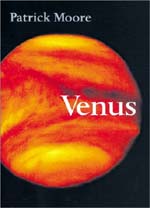Monday, March 22, 2004
 Book Review: Venus, by Patrick Moore
Book Review: Venus, by Patrick MooreItís been a while since Iíve posted a book review, and Iíve picked up several books of late and have gotten bogged down in them for one reason or another without finishing them. But I thoroughly enjoyed this book and finished it off on the ride to work this morning.
When I was a kid a got for my birthday at least one book on astronomy authored by Patrick Moore, which must have comes from one of my British relatives, so when I saw this in a bookstore I knew it would be a fun read. There's not many books out there that look at our "sister" planet, having been thoroughly eclipsed in recent days by Mars. But Moore does an excellent job. He starts off with the history of our knowledge of the inner planet, first worshipped as one of the central deities of the Aztecs, the personification of the goddess of love to the Ancient Greeks and Romans. After the round-up of the mythic history comes the scientific history, starting with the time when the first telescopes were turned towards Venus, none of which revealed much more than a featureless blur, with occasional blotches which were likely figments of the imagination (it is telling that Percival Lowell, best known for spying the non-existent canals on Mars, also spotted them on Venus). Moore also looks at the subject of Neith, a moon of Venus spotted by a number of 17th century astronomers, but subsequently proven to be ghost reflections within the telescopes of the viewers. He also looks at the fascinating history of the transits of Venus Ė a twice-per-century event, one of which happens to come this summer Ė which was the quest of several scientific expeditions, including one involving Captain Cook. What I had never known until now was why this was so important: other than the obvious idea of being able to precisely measure the size of the planet, an accurate recording of the start and exit of a transit of Venus could be used to help determine how far away the Earth is from the Sun. Venus' thick atmosphere ultimately confounded clear measurements of this effect, but the quest literally sent people to the far ends of the earth.
Centuries of observation turned up little that was concrete about the planet, and it was only until the early 1960s when radio beams were bounced off the planet that it was learned that the Venusian day is actually longer than its year Ė and that it spins backwards to boot. Up until the time of the first spacecraft sent to the planet, very little was solidly known about the planet, and I can remember reading astronomy books from the 50s depicting the planet as a vast Precambrian-like swamp planet.
The spacecrafts proved them wrong, especially the first Russian Venera which was crushed by atmospheric pressure before it could arrive on the surface intact. The first ships to survive the journey intact had to withstand pressures equivalent to a mile under the ocean, temperatures that can melt lead, and sulphuric acid droplets in the atmosphere. None of the landers that made it down intact lasted for much more than an hour. The end of the book is filled with images of the topography of the planet, Venusí veil of clouds stripped away by Magellanís imaging radar.
Easily the best book Iíve read about the planet, and Moore's easy, talkative style drew me in and held my attention until I had finished it off.
Subscribe to Posts [Atom]
